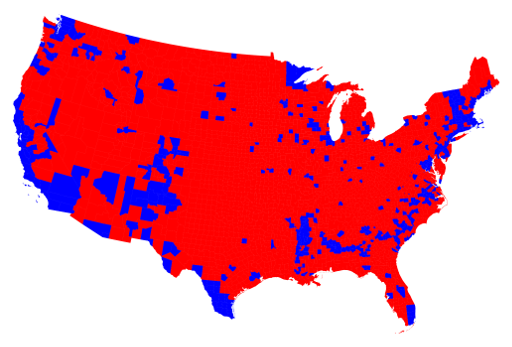The marginalization of the rural vote
The marginalization of the rural vote
Article II, Section 1, Clause 2 of the Constitution gives the power to state legislatures to determine the manner by which each state’s electors are chosen. These electors are usually nominated by the political parties at their state conventions, and are usually state-elected officials, party leaders or people with strong affiliations with the presidential candidates.
Neither the Constitution, or federal law, requires that the electors actually vote for their party’s candidate. Twenty-seven states do have laws requiring the electors to vote for their party’s candidate, while in the remaining states, no such laws apply.
During the 1787 Constitutional Convention, one of the most perplexing issues was that of how to elect a president. Some of those in attendance wanted to rely on a democratic popular vote, while others argued that Congress should select the president. The compromise was the Electoral College. Keep in mind that in 1787, no other country in the world directly elected its chief executive, this was a departure from the norm and a venture into uncharted territory. Furthermore, after breaking free of British rule, there was a deep-seated distrust of executive power. Eventually a compromise was reached based on the idea of electoral intermediaries. The issue now became, ‘How many electors to assign to each state?’ All of this must be taken in context. In 1787, there were no political parties and it was assumed that electors would vote according to their own discretion, not cast their votes as instructed by a state or national party. Suffice it to say that the Electoral College is not a perfect system, but it is what we have and is provided for in the Constitution
Let us now discuss the popular vote as a national electoral mechanism. On the face of it, the ‘one man, one vote system’ would appear to be the foundation of a democratic system. And that would be so if the system was used to select a candidate within a small, homogeneous population. But this is not the case regarding the United States, with its diverse demographics. The ‘one man, one vote’ system essentially handcuffs the entire country to the political whims of a few densely populated regions, much the same way that rural counties in every state are handcuffed to the political desires of the densely populated cities within that state.
For the sake of discussion, let us take Colorado as an example, although any state would highlight the same issue.

Eleven counties along the Front Range, each with over 100,000 residents, account for 85.01% of the population. These 11, mostly urban, counties, effectively dictate the politics and lifestyle for the remaining 53, mostly rural counties in the state. Is this fair or equitable to the residents of say, Moffitt, Baca, Montez or Lincoln counties? You may as well never count the votes in rural counties as they essentially have no value under the present system. Regardless of which side of the political divide you are on, it is obvious that a more equitable system is required to resolve not only state, but federal elections as well. Due to the disparity in population densities, within the country as well as within the states, the popular vote marginalizes the votes in rural America as well as in the rural counties within each state, so we need to ‘think out of the box’ to come up with a more equitable system.
As the Electoral College system is already mentioned in the Constitution, let us keep that system in place to avoid unnecessary complication, and simply modify it as it applies to federal elections, and include a similar system within each state.
Let us first take a look at the system as we could apply it to the state, again using Colorado as an example. Serious study would need to be applied to this idea, but for the sake of argument, let us say that each Colorado county with a population below or equal to 100,000 would be given one state electoral vote. Any county with more than 100,000 residents would receive two state electoral votes. This effectively gives the 11, heavily populated Front Range counties, a total (populations of the counties as of 2020) of 22 state electoral votes. The remaining, mostly rural counties, would then control 53 state electoral votes. The popular vote, within each county would then determine the awarding of each counties vote, or votes. The state electoral votes would then be apportioned as a fraction of the total, determined by the county electoral votes.
As an example, let us say hypothetically that all 11 of the densely populated counties along the Front Range voted for Candidate A. This would yield 22 state electoral votes for that candidate. And let us assume that another 10 of the rural counties also voted for Candidate A. This yields 32 electoral votes for Candidate A. The remaining rural counties would have voted for Candidate B, which would yield a total of 43 state electoral votes for Candidate B. At the moment, Colorado has 9 electoral votes. Candidate A would receive 9 x (32/75), or 3.84 votes, while Candidate B would receive 9 x (43/75), or 5.16 votes. Neither candidate would automatically be assigned all 9 electoral votes for the state.
The system described above would tend to alleviate the issue of non-represented rural counties as per the present system utilized to allocate the state’s electoral votes. If this method was then utilized to assign all 50 states electoral votes, then we would have a more valid representation of all the American voters, and would go far in actually valuing the votes from those American’s who do not live, and vote, in the densely populated areas of the country.







Post a Comment